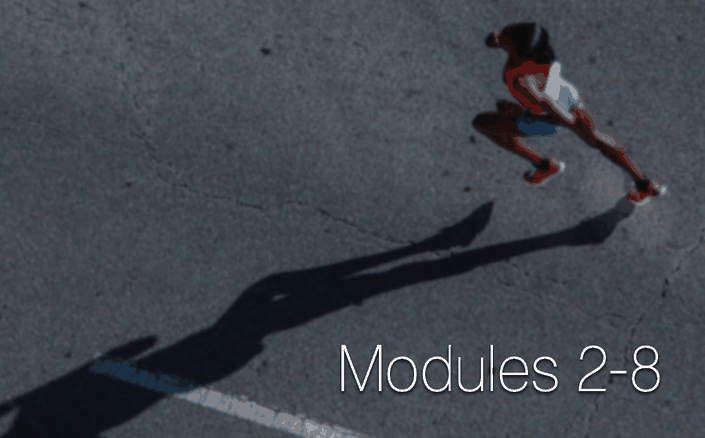
Treating and Training the Female Runner Modules 2-8
(or any Female Athlete): Modules 2-8
Treating and Training
|
Course Tools |
Course Description:
MODULES 2-8
Module One provided a conceptual introduction to the application of the Piston Science foundational concepts to running and fitness without pain or pelvic/abdominal health considerations. Topics introduced: Dynamic central control that matches the demands of running, running form, impact loading, pressure management, rebuilding automaticity and promoting carryover.
Modules 2-8 Completion of the full course will equip pros to move from concept to execution. The clinical reasoning strategies, functional evaluation and treatment skills needed to assess and address the full clinical picture for female runners and athletes at any level are provided.
Treating and Training the Female Runner (or any Female Athlete) Online provides a robust, interactive learning experience that bridges the gap between our understanding of musculoskeletal, and sports performance with pelvic, abdominal and pregnancy/postpartum health considerations for female athletes. The course is intended to be an entry level and all external/functional opportunity. Musculoskeletal and sports medicine practitioners unfamiliar with pelvic health AND pelvic health providers unsure of how to prepare a patient for a return to fitness and sport to gain the foundational knowledge, clinical reasoning and relevant skills to integratively assess and address the full clinical picture for their female runners. The goal is to build strategies that free runners and all athletes from rehab edicts and provide a path back to automatic, efficient and powerful movement, function and fitness without pain or pelvic/abdominal health considerations.
The strategies for assessment and treatment are very adaptable to telehealth. In addition to practicing the concepts in collaborative conversations throughout and labs, the online course now includes a home study case as an opportunity to practice course concepts and prepare you for engaging patients via telehealth. **(Information, reasoning, and strategies can be applied to other types of female athletes).
Pre-Course and Lab Requirements:
- Collect a video of yourself and one other person running* (*female runner/athlete is ideal for all videos). Videos should be from the front, side and behind.
- Collect pictures of yourself and one other person* from the front and side.
- Collect video of yourself, and one other person* performing bilateral single leg stance, squats, bilateral single leg squats, a squat jump and bilateral hops all from side and front views.
- Collect video from head to pelvis of yourself and one other person* taking a deep breath and then speaking or singing the ABC’s. Catching them laughing is a bonus! View should be from the side.
- Have a full length mirror on hand, room to move, and some type of resistance equipment on hand (bands, dumbbells, kettlebells, barbells, etc.).
Additional course options can be found here!
Click here to see the full course description Treating and Training the Female Runner (Modules 1-8)
Bundles
Women's Sports Medicine & Fitness
Includes:
- Foundations (Module 1)
- Treating and Training the Female Runner (Module 1)
- Female Athlete: Ready for Impact and High Intensity (Case Study)
Foundations + Running Series:
Bundle A
Includes:
- Treating and Training the Female Runner
- Foundations (Modules 1-7)
Foundations + Running Series:
Bundle B
Includes:
- Treating and Training the Female Runner
- Foundations (Modules 1-4)
Course Objectives:
Equip and empower all professionals that treat female runners (or any female athlete) with the ability to understand at depth, reason through and build programs that simultaneously address musculoskeletal, pelvic and performance needs. At the end of the course, participants will be able to address clinical questions including:
- How can we use running and fitness programs to return women simultaneously to optimal musculoskeletal, pelvic and performance health, instead of eliminating it until they are “better”?
- How does impact control, or lack thereof, simultaneously contribute to common musculoskeletal and pelvic health presentations in female runners?
- How do we create dynamic control for a runner versus stiff stability offered by abdominal hollowing, bracing or “core” stabilizing ideas?
- Why are young women who have never had children leaking during running and how does that affect running efficiency and performance? (Hint: Their pelvic floors aren’t weak).
- How do we harness optimal intra-abdominal pressure for trunk control without contributing to pelvic and abdominal health issues?
- How do you build a program to prepare a new mom to return to running post-partum?
- How are painful hips or low back while running and painful sex intertwined?
- What is the path back to running for women with pelvic organ prolapse?
- How does diastasis recti impact trunk and pelvic control in running?
- What running form considerations can be modified to address musculoskeletal, pelvic/abdominal, and performance needs?
- How do we recreate automaticity and carryover to remove the need for runners and athletes to be over-cued and to overthink about breathing, alignment/form and rehab strategies? (Hint: It’s not with strengthening programs)
- How do we build resilience in our female runners to prevent future injuries? **
Course Audience:
This course is intended to equip and empower professionals with the current evidence, theoretical constructs, clinical reasoning and practical tools to help treat and train female runners (or any female athlete). The information bridges the gap between musculoskeletal, and sports performance and pelvic, abdominal and pregnancy/postpartum health considerations for female athletes. All participants should apply the information within their State/jurisdictional scope of practice.
The PT/DC (medical pros) The course is intended to be an entry level (and all external/functional) opportunity for musculoskeletal and sports medicine practitioners unfamiliar with pelvic health AND pelvic health providers unsure of how to prepare a patient for a return to fitness and sport to gain the foundational knowledge, clinical reasoning and relevant skills to integratively assess and address the full clinical picture for their female runners (or any female athlete).
The PTA will gain insight into the theoretical basis for assessment process, and clinical reasoning behind the POC designed by the therapist. Course participation and self-reflective learning experiences with specific cueing, exercise guidelines, monitoring for signs of intolerance, program modifications, progression parameters and treatment methods will insure continuity of care.
The Athletic Trainer/Kinesiologist (AT/Kin) will gain insight into theory, evidence, reasoning and practical tools for integration of the POC into an athletes training program. Observation, and participation through self-reflection, will assist with monitoring and modifying an athelete’s program to keep pelvic, musculoskeletal, and performance health in mind.
Intended Audience: This course is intended for rehabilitation professionals. The course focus on clinical assessment, clinical reasoning and treatment strategy falls under the scope of rehabilitative intervention. Other professionals enter into this for informational purposes only to be understood and applied within their state/jurisdictional scope of practice.
Course Schedule:
Day One:
Module One: Foundational Concepts Applied to Running
Module Two: Clinical Reasoning for the Female Athlete
Module Three: Alignment/Form Assessment (Thoracic Cage in Pregnant and Postpartum Women)
Module Four: Detailed Assessments with Small Group, Self-Labs, and Self-Reflection
- Central Control System (Breath Mechanics, Pelvic Floor and Abdominals)
- Movement and Rotational Patterns
- Gait and Running Form Assessments
Day Two:
Module Five: Pelvic and Abdominal Health Integration and Case Applications
Module Six: Treatment Strategies: Impact
Module Seven: Treatment Strategies: Intra-abdominal Pressure
Module Eight: Rotation and Muscular Relationships that Support Reciprocation
Module Nine: Return to Run Reasoning (Running as Intervention)
Bonus: Home Study Case
I need a Certificate of Completion
After you have completed the course modules, look for a link “I need a certificate of completion” at the bottom of the course page. Click the link to be directed to your post-test at www.classmarker.com. You must score a minimum of 70% on this test in order to receive the certificate. After you have submitted the test, you will be provided with the option to download your certificate of completion. In addition, click the link to be directed to a course self-refection to optimize the application of your learning to clinical practice. Please follow the provided link to complete the course evaluation. We value your feedback!
Is the course eligible for CEU's?
Treating and Training the Female Runner will launch without CEUs. The FSBPT Procert program for certifying new courses no longer exists (all other JWPT professional courses are certified in 32+ states through Procert until Spring 2021). Until something emerges to take the place of the multi-state Procert program, you will need to retroactively submit the course to your individual state board for CEUs to apply to your re-licensure. You are responsible for understanding the certification process in your state.
Computer Compatibility Needs
This course is hosted on the teachable.com online streaming service designed to handle any system setup. So if you have a computer and an internet connection you should have access without issue. If you have issues with a slower bandwidth connection then you can change the video settings to a lower quality to help improve any loading issues.
Get the newsletter
Don't wanna miss a blog or event update, new product announcement, or special subscriber discounts? Join the newsletter here:
Your Instructor

Julie Wiebe, PT, DPT has over twenty-five years of clinical experience in Sports Medicine and Pelvic Health, specializing in abdominopelvic, pregnancy and postpartum health for fit and athletic populations. Her passion is to return active patients to fitness and sport after injury and pregnancy and equip professionals to do the same. She has pioneered an integrative approach to promote pelvic health in and through movement and fitness. These strategies have been successful incorporated by medical providers, rehab practitioners, and fitness professionals into a variety of populations (orthopedics, sports medicine, pelvic health, neurology, and pediatrics). Dr. Wiebe is a sought-after speaker delivering evidenced-based continuing education coursework, lectures, and curriculum at academic institutions, clinics, conferences, and professional organizations internationally. A published author, her research interests focus on the interplay of athleticism and pelvic health to inform screening tools and multifactorial intervention strategies. Julie provides direct cash-based care to fit and athletic populations through telehealth and her clinical practice.
